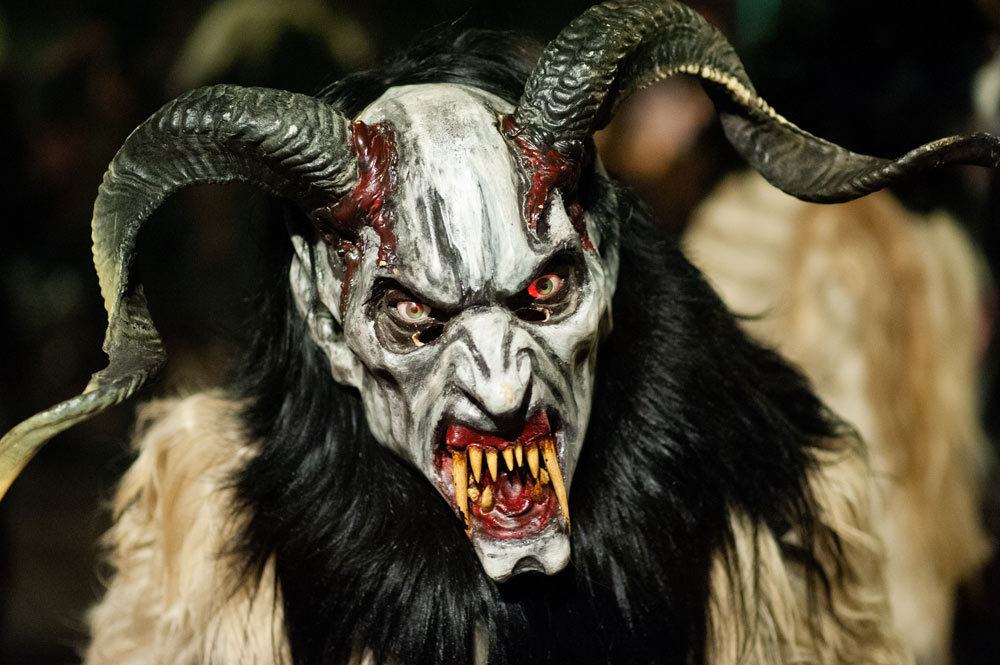If you’re looking to experience unique winter traditions in Europe beyond the usual Christmas markets, Austria is the perfect destination. The following chapters will give you an idea of what is the Krampus Parade in Austria, where and when it happens.
Origins
Krampus is a mythological figure with horns that usually accompanies St. Nicholas on the night of the 5th to 6th of December. They both are central figures in Central and Eastern European winter traditions. They visit small children and evaluate their behavior. St. Nicholas rewards the good ones, while Krampus punishes those naughty ones. Krampus usually uses birch rods and coal.
The Word Krampus originated in Bavarian – krampn, meaning the dead, or in German – kramp-en, meaning claw.
People portray Krampus in a way that mirrors our usual imagery of the devil or demons. Half-man, half-goat. An anthropomorphic persona with horns, fur, a hooked nose, a beard, dark hair, and a long tongue. Some people suggest that his look has some antisemitic vibes, particularly the portrayal of the hooked nose. Although the Krampus should represent the otherness, there are often subtle signs that resemble the antisemitic depictions of Jews.
At a certain point in history, Catholic traditions merged with the pagan customs already in the Alpine regions. People would mask themselves as devils, don animal furs, and participate in a procession called **Perchtenlaufen**, an ancient pagan ritual. This blending of traditions is often seen as the precursor to today’s Krampus Parades. Villagers believed Krampus and his perchten roamed the Tyrolean Alps causing chaos, while parents used his legend to scare children into good behavior. Today, Krampus is celebrated as a rebellious anti-hero in festive events, embraced by Tyroleans as a symbol of defiance against the commercialized Santa Claus.

Krampus Parades
A big part of the parade is the Krampuslauf or the Krampus Run. All the participants dressed in masks run down the streets and chase the spectators. They may growl, shake chains, or move sticks and whips. When looking at some older footage, they all seem to act and behave quite dangerously and create an aura of fear around them.
Krampuses also act out certain scenes and try to interact with the crowd. They can punish the naughty children or perform playful acts of mischief.
There have been reports of some spectators reacting angrily to the Krampuses’ playful whipping, leading to altercations. In some instances, these confrontations escalated, with several people reportedly ending up in the hospital with broken bones.
The parades also try to showcase the Krampus costumes. The costumes and masks are usually handcrafted, including horns, bells, and fur.
Fire shows and drumming are another popular aspects of the parades. The drumming tends to establish a tribal and intense atmosphere.
After the Krampus Run, you can continue and enjoy yourself at the after-party at the local market, stall, or pub. Traditional Austrian fare, including sausages, mulled wine, and pastries, is typically served.
Where and When
The above lines have outlined what is the Krampus Parade in Austria, but now is the time to find out when and where they happen.
It is usually early December (5th, 6th), in some cases late November when cities like Salzburg, Innsbruck, Graz, Klagenfurt, Villach, Bad Gastein, Bischofshofen, St. Johann im Pongau, Telfs (Tyrol) host this wild festivities. Many of them concentrate in the city centers and near Christmas markets. The parades always happen during the night.
The most famous one is in Salzburg, the family-friendly one in Graz, and the oldest in St. Johann im Pongau.
Sources:
wiki
tripsavvy.com